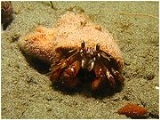
Pagurus armatus
Encyclopedia
Pagurus armatus, the armed hermit crab or black-eyed hermit crab, is a species
of hermit crab
found in the eastern Pacific Ocean
of the United States
and British Columbia
, Canada
.
length of 43 mm (1.7 in). The legs, including the claws, have bands of colour, in red, orange and white, and the claws bear short spines on the dorsal surface. The eyestalk
s are short, but bear large black compound eyes. P. armatus can be told apart from the similar P. ochotensis by the spines on its claws, which in P. ochotensis are replaced by granules. The two species are so similar that they have sometimes been considered members of the same species, but are now generally thought to be two distinct species.
, being particularly abundant in sea pen
beds, at depths of up to 117 m (384 ft)
by James Dwight Dana
. The holotype
of P. armatus was lost in the Great Chicago Fire
of 1871, and has been replaced with a lectotype
.
Species
In biology, a species is one of the basic units of biological classification and a taxonomic rank. A species is often defined as a group of organisms capable of interbreeding and producing fertile offspring. While in many cases this definition is adequate, more precise or differing measures are...
of hermit crab
Hermit crab
Hermit crabs are decapod crustaceans of the superfamily Paguroidea. Most of the 1100 species possess an asymmetrical abdomen which is concealed in an empty gastropod shell that is carried around by the hermit crab.-Description:...
found in the eastern Pacific Ocean
Pacific Ocean
The Pacific Ocean is the largest of the Earth's oceanic divisions. It extends from the Arctic in the north to the Southern Ocean in the south, bounded by Asia and Australia in the west, and the Americas in the east.At 165.2 million square kilometres in area, this largest division of the World...
of the United States
United States
The United States of America is a federal constitutional republic comprising fifty states and a federal district...
and British Columbia
British Columbia
British Columbia is the westernmost of Canada's provinces and is known for its natural beauty, as reflected in its Latin motto, Splendor sine occasu . Its name was chosen by Queen Victoria in 1858...
, Canada
Canada
Canada is a North American country consisting of ten provinces and three territories. Located in the northern part of the continent, it extends from the Atlantic Ocean in the east to the Pacific Ocean in the west, and northward into the Arctic Ocean...
.
Description
P. armatus is one of the largest species of hermit crab: adults may reach a carapaceCarapace
A carapace is a dorsal section of the exoskeleton or shell in a number of animal groups, including arthropods such as crustaceans and arachnids, as well as vertebrates such as turtles and tortoises. In turtles and tortoises, the underside is called the plastron.-Crustaceans:In crustaceans, the...
length of 43 mm (1.7 in). The legs, including the claws, have bands of colour, in red, orange and white, and the claws bear short spines on the dorsal surface. The eyestalk
Eyestalk
In anatomy, an eyestalk is a protrusion that extends the eye away from the body, giving the eye a better field of view than if it were unextended. It is common in nature and in fiction....
s are short, but bear large black compound eyes. P. armatus can be told apart from the similar P. ochotensis by the spines on its claws, which in P. ochotensis are replaced by granules. The two species are so similar that they have sometimes been considered members of the same species, but are now generally thought to be two distinct species.
Ecology
P. armatus lives on a variety of substratesSubstrate (biology)
In biology a substrate is the surface a plant or animal lives upon and grows on. A substrate can include biotic or abiotic materials and animals. For example, encrusting algae that lives on a rock can be substrate for another animal that lives on top of the algae. See also substrate .-External...
, being particularly abundant in sea pen
Sea pen
Sea pens are colonial marine cnidarians belonging to the order Pennatulacea. There are 14 families within the order; they are thought to have a cosmopolitan distribution in tropical and temperate waters worldwide...
beds, at depths of up to 117 m (384 ft)
Type specimen
P. armatus was originally described (under the name Bernhardus armatus) from Puget SoundPuget Sound
Puget Sound is a sound in the U.S. state of Washington. It is a complex estuarine system of interconnected marine waterways and basins, with one major and one minor connection to the Strait of Juan de Fuca and the Pacific Ocean — Admiralty Inlet being the major connection and...
by James Dwight Dana
James Dwight Dana
James Dwight Dana was an American geologist, mineralogist and zoologist. He made pioneering studies of mountain-building, volcanic activity, and the origin and structure of continents and oceans around the world.-Early life and career:...
. The holotype
Holotype
A holotype is a single physical example of an organism, known to have been used when the species was formally described. It is either the single such physical example or one of several such, but explicitly designated as the holotype...
of P. armatus was lost in the Great Chicago Fire
Great Chicago Fire
The Great Chicago Fire was a conflagration that burned from Sunday, October 8, to early Tuesday, October 10, 1871, killing hundreds and destroying about in Chicago, Illinois. Though the fire was one of the largest U.S...
of 1871, and has been replaced with a lectotype
Lectotype
In botanical nomenclature and zoological nomenclature, a lectotype is a kind of name-bearing type. When a species was originally described on the basis of a name-bearing type consisting of multiple specimens, one of those may be designated as the lectotype...
.

